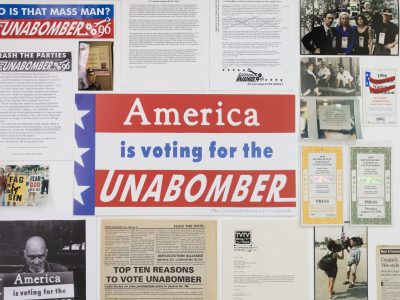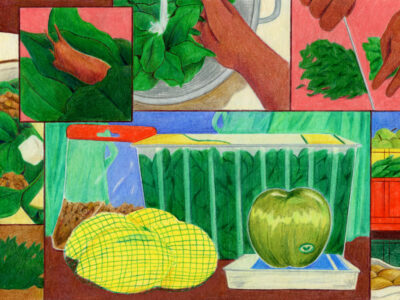WP_Post Object
(
[ID] => 9725
[post_author] => 15
[post_date] => 2025-10-28 19:30:22
[post_date_gmt] => 2025-10-28 19:30:22
[post_content] =>
Now, more than ever, we need art to do the heavy lifting of defining our values.
Cultural Currency is a bi-monthly romp through the intersection of art and capital with writer Cara Marsh Sheffler.
In the art world this year, many a gallery’s story has ended with Chapter 11. For those who’ve been paying attention, this wasn’t surprising. Art sales are slipping everywhere, down as much as 35% at Art Basel. This month, the Financial Times reported that blue chip Hauser & Wirth’s London profits have slid a staggering 90%. August mid-tier galleries have begun shuttering with alarming frequency: Blum, Kasmin, and Venus Over Manhattan, to name a few. For artists and galleries alike, the walls are literally and metaphorically caving in: the model of an entire industry predicated on selling to a few rich people is no longer working.
When the hero’s journey comes to its final chapter, a certain existential reckoning occurs. The life and death of ideas is very real: many far outlive their usefulness, and perhaps one that needs to die right now is the idea that art should exist on the market principally as a financial tool. Art fairs are expensive, rents are obscene, and a global economic downturn accented with the panic and chaos of trade wars and ethno-nationalism all point toward the necessity of conservative budgets and cost-cutting. Yes, the tie between money, power, and art is irrefutable, the backbone and lifeblood of art history. But as the midtier market collapses, it might be nice to finally unfuck the gap between the hand-to-mouth life of the artist and the value of art in the market, beginning with a trial separation—at least as a thought exercise—between money and art.
Now, more than ever, we need art to do the heavy lifting of defining our values. Alternative thought is essential when the capitalistic world has agreed—with zero referendum—that artificial thought is in any way preferential or superior. By subscribing to the centrism that masquerades as progressivism in the United States, the art world lost touch with the political landscape and, with that disorientation, any ability to question it. Amid the art market highs and market-oriented inclusivity, art has also lost its critical capacity.
But what is the value of art that cannot be sold? What might be the purpose of art that is simply not meant to sit aside a red dot? Historically, of course, we have performance art and Situationism, along with their descendants. But, beyond art that is merely difficult to commodify, what does an expression of cultural values look like when consciously uncoupled from the art market?
I pondered these questions as I walked around my favorite show I have seen all year, Lydia Eccles’ “Jokes About Bombs Will Not Be Taken Lightly,” which was up at Goswell Road, an artist-run space in Paris, from May 15 until June 14. In 1995, Eccles, a Boston-based artist, had one hell of an idea for an art project. Rather than taking a ho-hum trip to the supply store, she nominated the Unabomber—at the height of his anonymous reign of terror—in the 1996 US presidential election. The show was a documentation of that campaign and the ensuing pen-pal relationship Eccles formed with Ted Kaczynski after his arrest and throughout his incarceration.
Conceptual art has given us everything from Chris Burden having a friend shoot him to Agnes Denes turning a strip of downtown Manhattan to a wheatfield. Art in this vein pushes what can be a canvas for expression: the human body, landfill. But never before had I seen an artist decide their chosen medium was a presidential election. By participating in the political arena with all the familiar trappings of the era—signs, slogans, bumper stickers, and even a dedicated camera crew—Eccles showed a presidential campaign for what it is: an hysterical circus that plays to our basest fears, one where infamy and fame are interchangeable.
Eccles documents the Unabomber’s “run” alongside his more literal run from the law and the dance he did with the media, most notably and implausibly with Bob Guccione. Her prolific campaigning warranted its own inane and disturbingly underinformed coverage. At one point in the winter of 1996, WRKO radio reported, “There are more Unabomber signs than there are for Clinton, Gore, or all the Republicans, so it looks like the Unabomber is leading in this precinct.” In a time of Luigi Mangione fandom and a renewed, bi-partisan interest in Kaczynski, “Jokes About Bombs” offered a riveting, prescient, wholly prophetic anti-capitalist critique of technology’s role in a broken political system. The phrase “artistic intervention” has been worn out to the point of farce, but Eccles had staged one in a presidential election and a federal manhunt.
I had to own the catalogue.
But: how to get it home??? The cover showed an old-fashioned political sign stuck in sludgy snow amid a warren of placards for Bob Dole and Pat Buchanan:
DON’T WASTE YOUR VOTE!
Write-in for President
UNABOMBER ’96
If elected he will not serve
★ VOTE AGAINST REPUBLICANS
★ VOTE AGAINST DEMOCRATS
★ VOTE AGAINST CORPORATE TECHNOLOGY
All you have to lose is the political illusion…
ARE YOU READY FOR THE RUPTURE?
I imagined myself at customs, declaring this tome. Anthony Stephenson, the gallery’s convivial proprietor, asked me if it would be so terrible to be stuck in France forever. He had a point. Still, I demurred and, frankly, chickened out of buying a book I really wanted to own.
In my own cowardice, I recognized that Eccles’ show was lightning in a bottle, and that my own hesitation indicated that I was in the presence of something genuinely avant-garde. I’d been conditioned to the shopping malls of art fairs, swapping out the Orange Julius and TCBY of my New Jersey childhood for the (aptly named) Ruinart Champagne Lounge. Despite my arty existence, in that moment of contact, I realized that coming across art that is actually outré (if you like your French cultural theory) or verboten (if you prefer your Germans), and has purpose, simply had not been my experience of most galleries where, at best, I sigh and think “Gee, if only I had a cool $30K lying around…” Like the idea of owning its catalogue, the show itself freaked me out a bit. I felt alive in my mind and privileged to be in the room, as well as to meet Eccles herself.
In its early pages, the catalogue for “Jokes About Bombs” contains the text of a speech James Baldwin gave in 1962, “Art is here to prove, and to help one bear, the fact that all safety is an illusion. All artists are divorced from and even opposed to necessarily any system whatever.” These are, of course, the sorts of moral standards we expect whenever we read James Baldwin, who had a sixth sense for integrity the way sea turtles and migratory birds can use the earth’s magnetic fields for navigation. While I ultimately left the catalogue behind, as spring turned to summer, I let his words guide my art viewing.
I came across two moral stand-outs in London. The first was Ed Atkins at the Tate Britain, best known for his computer-generated, incredibly unsettling videos that plumb the uncanny valley. Atkins has been exploring the genre for decades, well ahead of AI moral and economic panic. Seeing his career retrospective made me think of a Democracy Now interview I saw with Karen Hao, who pointed out that, as we have no agreed-upon scientific definition of human intelligence, what, exactly, is Artificial Intelligence? Is it merely a projection of our perceived notion of intelligence, skewed entirely by capitalistic values? Are we creating “intelligent” bots with the same level of foresight and ethical depth as rare dog breeds concocted by bored, rich people that are so helpless they cannot even fuck on their own? (A sharp new ad for Merriam-Webster slyly posits their dictionary as an LLM and ends with the tagline, “There’s artificial intelligence, and then there is actual intelligence.”)
The second stand-out was “Leigh Bowery!” at the Tate Modern, a retrospective of fashion and nightclubbing as artistic expression. The text at the entrance to the exhibit read: “In his brief life Bowery was described as many things. Among them: fashion designer, club monster, human sculpture, nude model, vaudeville drunkard, anarchic auteur, pop surrealist, clown without a circus, piece of moving furniture, modern art on legs. However, he declared, ‘if you label me, you negate me,’ and always refused classification, commodification, and conformity.” The show was a riveting reminder of transgression and artistic expression in the face of AIDS, discrimination, and the rise of conservatism—and a call for the same as we face rising global authoritarianism today. In an era where fashion often feels like the reductio ad absurdum of vapid aspirational mass consumption amid our ever more precarious existences, online and in debt, Bowery’s ability to imbue costume with so much intellectual ambition and drive floored me.
These three exhibitions were recentering as reminders that art’s purpose—its true value—shouldn’t be monetary. Moreover, those figures don’t mean much just before a crash, when the numbers game is more of a hiding-the-real-numbers game. While blue chip galleries and their deep war chests can ride out the chaos for now, Hauser & Wirth’s stumble may tell us otherwise.
Right now, it is vital to uncouple cultural values from the marketplace. Commercial worth has always been baked into ideologies that align with power, whether you’re talking about royal court painters or the CIA and Abstract Expressionism. The market then reinforces that notion of value over and over again in a way that resonates into institutions and educational systems. Yes, that art market is experiencing a downturn that might spell collapse for many. It won’t be pleasant. However, chaos presents an opportunity for a reappraisal, and for finding what was lost. I would argue that—whether you love it or hate it—art that passes the Baldwin litmus test is a great place to start understanding what art with a valid critical stance looks like at this very moment in time.
Such art demands the same moral clarity from its viewers, too: I did return to Goswell Road this summer, and I bought the catalogue for “Jokes About Bombs Will Not Be Taken Lightly.” Despite my concerns, the book made it home through customs.
[post_title] => The Value of Art That Can't Be Sold
[post_excerpt] => Now, more than ever, we need art to do the heavy lifting of defining our values.
[post_status] => publish
[comment_status] => closed
[ping_status] => closed
[post_password] =>
[post_name] => cultural-currency-value-art-cant-be-sold-galleries-profits-economy-goswell-road-lydia-eccles
[to_ping] =>
[pinged] =>
[post_modified] => 2025-10-28 19:30:26
[post_modified_gmt] => 2025-10-28 19:30:26
[post_content_filtered] =>
[post_parent] => 0
[guid] => https://conversationalist.org/?p=9725
[menu_order] => 0
[post_type] => post
[post_mime_type] =>
[comment_count] => 0
[filter] => raw
)



















